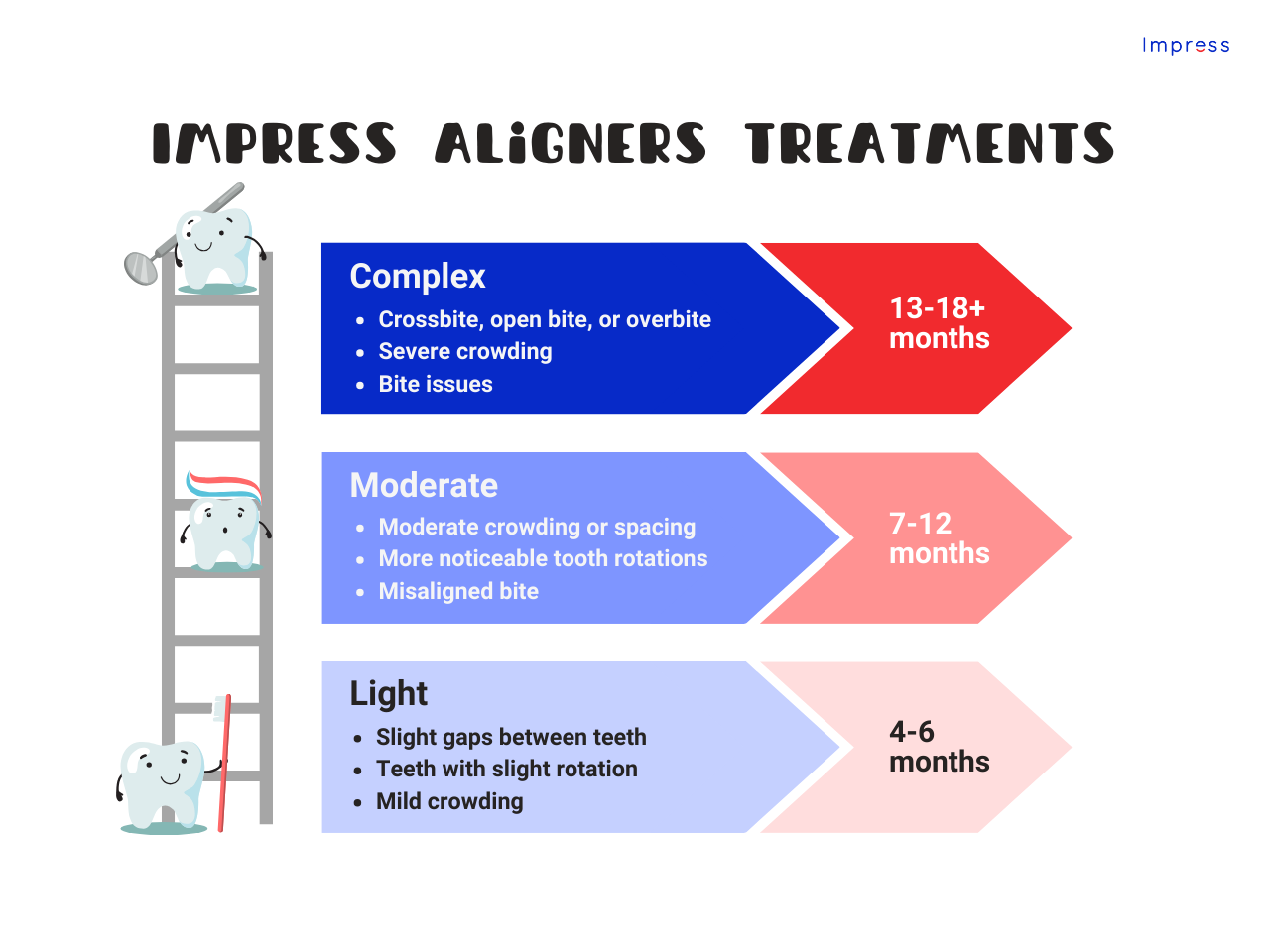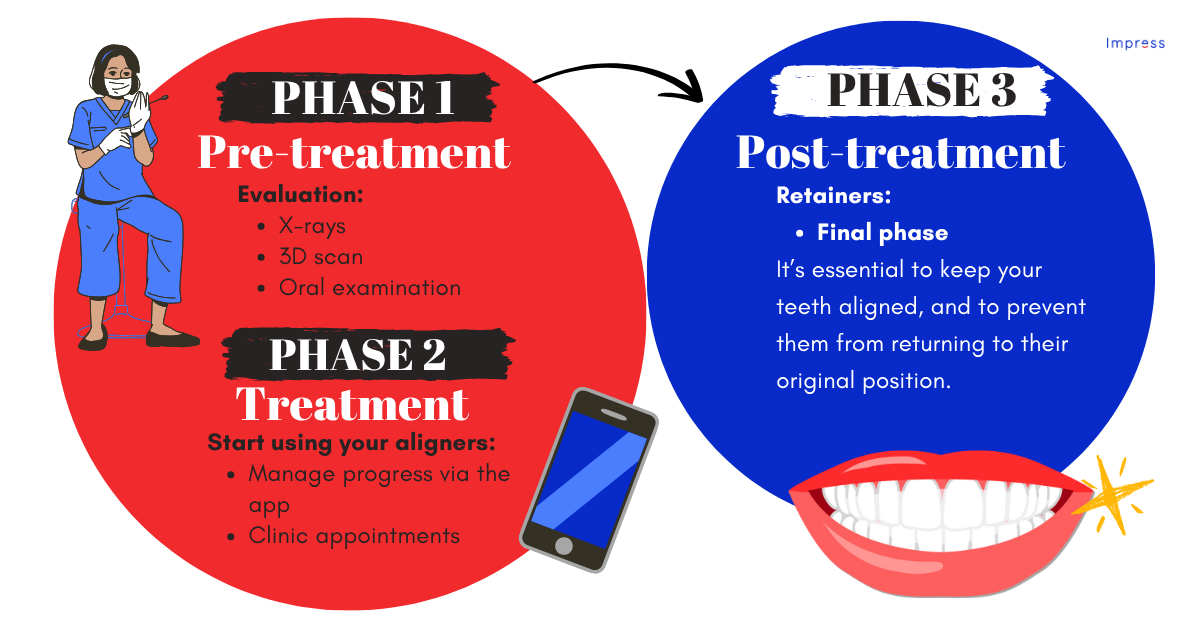Orthodontic treatments from Impress: what we offer
The Impress method is a revolutionary way to align teeth. Our orthodontic treatments have helped over 200,000 happy patients to date with comprehensive orthodontic care.
Starting your invisible orthodontic treatment with Impress gives you access to lots of benefits that help your treatment go smoothly.
- Comfortable and removable aligners
- Little to no impact on your lifestyle
- Track your treatment progress using the Impress app
- Speak to a member of our patient care team 7 days a week
So, what is orthodontic treatment?
Orthodontics relates to the branch of dentistry that helps to straighten your teeth and resolve dental issues. The focus is usually on cases of crowding, misalignment and malocclusions.
Braces are often the device that comes to mind first when you think about fixing your teeth, but there is a range of orthodontic appliances that can be used to straighten your smile.
If the extent of orthodontic intervention needed can be addressed with removable braces, and you don't want to compromise your lifestyle, it's likely that you prefer the idea of using removable aligners.
How do I get orthodontic treatment?
Referrals to orthodontic specialists are usually made by a dentist if using public health or private services. The option via the public health route, however, is usually for fixed braces, which are a long-term treatment.
It's usually expected that there will be a lengthy waiting list to wait for braces via the public health system, too. This can be further impacted by clinic availability, and, depending on your location in the UK.
As a result, it can make receiving dental treatment quite a lengthy process. This is especially true if you want to complete your treatment for a certain occasion. It's also worth noting that there is minimal choice if you want a certain type of brace via the NHS.
The waiting time can often be overcome by using a private orthodontist. Impress offers multiple days and times for free orthodontic evaluations, meaning you can be assessed quickly.
During your appointment, the orthodontist assessing your case will determine if you need preliminary work before you can start realigning your teeth and jaws with fixed or removable appliances.
Find a local clinic for your evaluationTypes of invisible orthodontic treatments from Impress
We have different types of orthodontic treatment depending on the extent of your malocclusion and orthodontic problem: Impress Light, Impress Moderate and Impress for Complex cases. Let's take a look at what each of them means now.
Impress Light Aligners
The Light Impress treatment is designed for patients who suffer from very small bite problems, crowding or minor gaps. Treatment can be completed in as little as four months in some cases, and is intended for both adult and teen patients.
Impress Moderate Aligners
The Moderate Impress treatment is designed for patients suffering from slightly more complicated bite problems. This range of misalignments is not considered severe but typically requires multiple sets of aligners.
This can include:
- crowding
- gaps
- bite issues
You can typically see results in as little as six months. Before treatment, you may be advised that attachments, or interproximal reduction, are needed before starting your treatment.
All of the Impress treatments consist of 3 main phases, which we'll discuss a little later.
Impress Aligners for Complex Cases
The Impress Plus treatment is for people who have more severe bite problems with crowding or gaps. For this reason, the price of the Impress Plus treatment is a little higher than that of the standard. In addition, the duration of these treatments is also somewhat longer and can use a combination of braces, distalisers and aligners.

Phases of the Impress orthodontic treatment process
As mentioned earlier, Impress treatments consist of 3 main phases. We’ll proceed to explain what each of them consists of so that you won’t be left with any questions. You can find out more about the price of clear aligner treatment with Impress on our aligner page.
Pre-treatment before orthodontics
In the first phase, diagnosis and pre-orthodontic dental treatments are carried out. During the consultation, X-rays, an oral exam and a 3D scan are performed to obtain a detailed and in-depth image of your oral cavity. Using the results, the medical team will diagnose your case and tell you if you need any pre-treatment preparation.
Pre-treatment advice can range from:
- performing dental cleanings
- advising you to treat any cavities that you haven't fixed
- placing crowns
- a dental extraction
- placing attachments for your aligner
- IPR
Once you've paid for your aligner treatment, your aligners are ordered and will start to be produced. After a few weeks, when you've done all the pre-treatment work, you can sit back and wait for your aligners to arrive.
Starting Orthodontic Treatment
This is the main phase of orthodontics. Once your aligners are ready, you will receive them at home. It's important that you notify Impress when you have them, as you’ll also need to book an appointment at the clinic to do the fitting and place attachments if it hasn't been done already. After this visit, you can proceed to use the first set of your aligners.

During this phase, visits to the clinic will be occasional thanks to the Impress app. Our team will be able to monitor your progress with the regular photos you upload, meaning you don't need to go to the clinic as often–saving you time on travel.
Most of the follow-up is done via the app weekly or every two weeks. Your orthodontist will advise you on the frequency you need to do this, and our medical team are on hand to supervise your case throughout the process.

Post-treatment dental retention
If you've worn your aligners correctly for the minimum recommended amount of time, your medical team will tell you that you're ready to move on to the next set of aligners until your final set. Result!
After completing the treatment phase, you move on to the final phase: retainers. Retainers are used to help maintain the results of your treatment so you don’t have to wear braces again. Remember that teeth continue moving throughout our lives, so it's important to wear retainers consistently.
What is IPR and what is it used for?
IPR (interproximal reduction), or dental stripping, is a small interdental polishing that is performed to eliminate the point of contact between the teeth. It is used to create the necessary space so that teeth can move into the correct position in the dental arch during aligner treatment.
What should I do if I lose an attachment or a button?
In the first instance, you should contact the medical team via the app. The buttons must be replaced as soon as possible. You should also remember that if you have buttons on both sides of your mouth, the aligner should not be used until all the buttons have been repositioned.
Attachments are movement enhancers in invisible orthodontics. So, although they are important and must be replaced, if necessary, you can be without them for a maximum period of 30 days.
We have several ways to help you achieve straighter teeth. You can get started right now by filling in our booking form, messaging us on WhatsApp, or calling us on +44 20 3808 1072. We look forward to your call.




